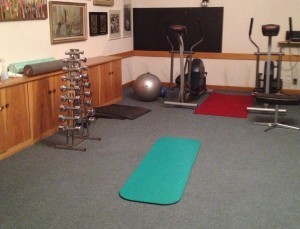Top 10 Benefits of Unilateral Training - Part II
To read Part I of this post click here.
#6 - IDs weak links What are your top three weak links? Quick don't take time to think. If you had to take some time to think about them then you probably aren't addressing them as much as you should in your program. Worse maybe you couldn't answer this question on the spot and don't know the answer. Worse still what if your opponent knew what your weak links were and exploited them during competition? Or if you became injured by not addressing them?
The good news is that you can fix your weak links, even if you're not sure what they are. Any time you perform a unilateral movement pay attention to L-R differences. Are you stronger on one side? Is your balance worse on one side? Do you move better on one side than the other?
Figuring out the answers to these will translate more effectively to enhanced performance than the best 'sports-specific' exercise ever will. Make notes in your training journal answering the above questions when you train. Where you are weaker do that side first. Where you don't move as well add in more stretches and mobility drills. And where you have discomfort seek out the best manual therapist you can find.
#7 - Additional EST work EST is energy system training and refers to training the various system of the body that provide fuel for our various activities. Cardio tends to be associated solely with aerobic training and therefore we don't use that term unless the duration and intensity justify it.
So how does unilateral training lend to EST? Well in a couple of ways. First, by using one limb you trigger muscles that typically don't get a lot of attention when two are used. Secondly the sets tend to last longer as you perform an equal number of reps for each limb. If you're not sure about this try doing twelve step ups on each leg with load. If you are not used to feeling out of breath when lifting be prepared to watch your heart rate soar. When pressed for time a unilateral metabolic circuit can be a great way to achieve a strength training session with an elevated heart rate.
#8 - Better recovery? While this is more anecdotal than supported by the primary literature there is the argument that training unilaterally allows for quicker recovery. This may be due to the fact that since lighter loads may be used the system is not taxed as much as during a bilateral training session. For example, it would be more taxing on the low back to perform barbell back squats with 405 lbs than the single leg version at 225 lbs.
It may also be a function of stabilizer versus mobilizer work with bilateral compared to unilateral training. Bilateral training relies more on prime movers and less on stabilizers whereas the opposite is true of unilateral training. It could be that the stress on the movers is the rate limiting step towards recovery however this is simply speculation.
#9 - Variety & options In terms of lifts and movements you can do more with unilateral training. It is easier to move through all three planes when only one limb is involved and the other limb is free to lift, rotate, reach, pivot...you get the idea. Typically the reason we would opt for bilateral training is that we are able to overload the system with more load. Such as the back squat with 405 lbs. However once we have this load on our shoulders we aren't going to be able to do much else.
In a unilateral scenario we aren't restricted by these higher loads and have more options to move.
#10 - Fewer equipment needs There is an expression about dumbbells and kettle bells that says 'everything you can do with a dumbbell you can do with a kettle bell, but not everything you can do with a kettle bell can you do with a dumbbell'. This is kind of similar to how you can think about unilateral training. Every exercise than can be done bilaterally can be done unilaterally but not every unilateral exercise can be done bilaterally.
So this gives you lots of options and means you don't need a lot in terms of equipment. For example, picture the last hotel gym you trained at. Here's mine.
[caption id="attachment_3829" align="alignleft" width="300"] My hotel gym in Switzerland.
One wall was bookshelves filled with books (in German), the other wall was covered with fine paintings and other art. The third wall had a grand piano against it and the fourth wall had windows along it.
In the middle of the room was a stability ball, a mat, a foam roller, a bench and a set up dummbbells unto 20 lbs. If I wanted to train bilaterally this set up would have been fairly ineffective. But when performing unilateral movements it served me just fine.
In my next post I will write the exact workout I did in this hotel gym. Feel free to print it out and use it on your next vacation. Or you could always play the piano.
Chris [fb-like]
When you subscribe to the blog, we will send you an e-mail when there are new updates on the site so you wouldn't miss them.

Comments 1
Guest - http://www.senatorwonderling.com
(website) on Thursday, 08 May 2014 09:21
Hi from United States! This is an excellent post and that I loved studying it